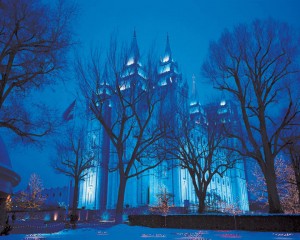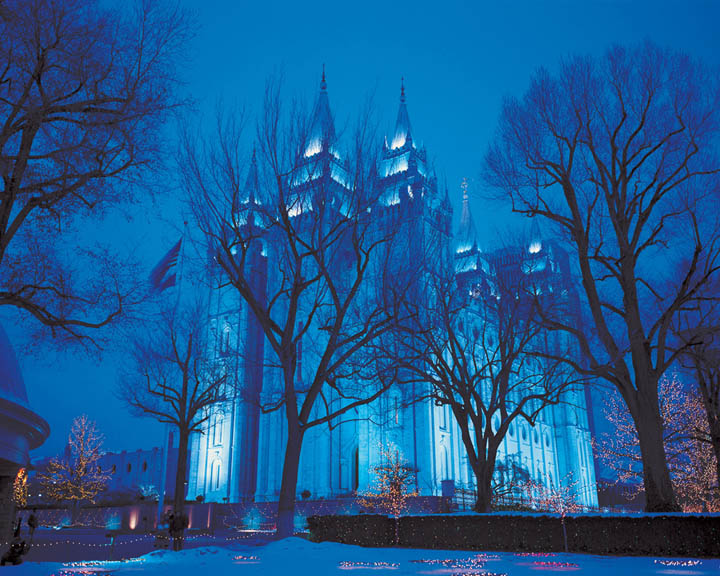 The temple in Salt Lake City, Utah has become a well-known symbol of the Church of Jesus Christ of Latter-day Saints, sometimes incorrectly known as the Mormon Church. This temple was prophesied by Isaiah in the scriptures. In 2 Nephi 12, Nephi, the second prophet of the Book of Mormon, quotes Isaiah (See Isaiah Chapter 2 for the King James translation of these verses.)
The temple in Salt Lake City, Utah has become a well-known symbol of the Church of Jesus Christ of Latter-day Saints, sometimes incorrectly known as the Mormon Church. This temple was prophesied by Isaiah in the scriptures. In 2 Nephi 12, Nephi, the second prophet of the Book of Mormon, quotes Isaiah (See Isaiah Chapter 2 for the King James translation of these verses.)
2 And it shall come to pass in the last days, when the mountain of the Lord’s house shall be established in the top of the mountains, and shall be exalted above the hills, and all nations shall flow unto it.
3 And many people shall go and say, Come ye, and let us go up to the mountain of the Lord, to the house of the God of Jacob; and he will teach us of his ways, and we will walk in his paths; for out of Zion shall go forth the law, and the word of the Lord from Jerusalem.
The saints had built temples before, but had been forced to abandon them when persecution forced them from their homes. Now the Saints had arrived in Salt Lake City, Utah, a place chosen by Brigham Young under God’s direction, a place they hoped to stay in safety. And so, on July 28, 1847, Brigham Young, the second prophet of the modern Church, announced: “Here we shall build a temple to our God.”
He, along with Wilfred Woodruff, who would later become a prophet, had seen visions of this temple built on a hill. It was Wilfred Woodruff’s vision that provided them with an understanding that the temple must be built of granite, although Brigham Young preferred other materials.
Construction of the temple began April 6, 1853. The railroads had not yet come to Salt Lake City and materials and tools had to be hauled into the temple site by ox team for many years. There were various interruptions to the work due to persecution from the outside. Ten years after the Saints arrived in Salt Lake, during a celebration of that day, they learned Johnson’s army was coming to settle the “Mormon question.” All work on the temple stopped and signs of construction, which was almost to ground level, was hidden, so the site appeared to be an empty field. This was to protect the site from the problems the Saints had faced in the past.
In 1887, the United States government decided to take ownership, without payment, of all church properties, forcing the Saints to pay rent for eight years on their own property, in order to continue building the temple. They did so and kept building, even though there was no sign at that point they’d ever be allowed to own and operate the temple.
The temple was finally dedicated in 1893, forty years after work began. Its building required great sacrifice among the people, even to the level of sending men to other countries to learn some of the skills needed to make the temple perfect.
Elder J. Golden Kimball, a church leader at the time of the temple’s completion, said:
“When I think about [the temple], every stone in it is a sermon to me. It tells of suffering, it tells of sacrifice, it preaches—every rock in it, preaches a discourse. When it was dedicated, it seemed to me that it was the greatest sermon that has ever been preached since the Sermon on the Mount. … Every window, every steeple, everything about the Temple speaks of the things of God, and gives evidence of the faith of the people who built it.”
To learn more about the construction of the Salt Lake Temple, please read, “A Temple to Exalt,” by Boyd K. Packer Ensign, Aug 1993, 7, which was the primary resource for this article.
About Terrie Lynn Bittner
The late Terrie Lynn Bittner—beloved wife, mother, grandmother, and friend—was the author of two homeschooling books and numerous articles, including several that appeared in Latter-day Saint magazines. She became a member of the Church at the age of 17 and began sharing her faith online in 1992.


